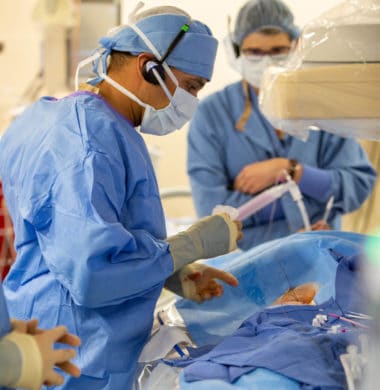Quick wins for cardiovascular wellness according to Dr Garcia
Quick wins for cardiovascular wellness according to Dr Garcia
Blog Article
Recognizing the Importance of Cardiology in Modern Health Care Services
Cardiology plays a critical function in modern medical care, particularly as heart condition remains to be the leading reason for death worldwide. Advances in diagnostics and treatment have actually transformed individual care, allowing earlier treatments and boosted results. Moreover, the change towards preventive cardiology encourages individuals to handle their wellness proactively. As modern technology remains to develop, the combination of ingenious remedies may further redefine cardiology's effect on public wellness, triggering a more detailed exam of arising patterns and their implications.
The Occurrence of Heart Problem and Its Effect On Public Wellness
Although heart condition continues to be the leading reason of fatality internationally, its influence extends much beyond individual patients to influence public health and wellness systems and economic climates. The high prevalence of cardiovascular disease puts a considerable pressure on health care sources, requiring increased financing for rehabilitation, therapy, and avoidance programs. Public health and wellness campaigns should resolve danger variables such as weight problems, smoking cigarettes, and inactive way of livings, which contribute significantly to the climbing incidence of heart conditions.Moreover, the economic worry connected with heart problem is immense, including not just straight medical expenses but likewise indirect expenditures related to shed performance and premature mortality. Areas encounter challenges in taking care of these prices, usually leading to variations in health care access and results. As the populace ages and lifestyle-related threats continue to intensify, the necessity for reliable cardiology interventions ends up being vital. Consequently, dealing with heart condition is not just a matter of specific health and wellness but also a critical public health and wellness concern.
Developments in Cardiac Diagnostics and Imaging Techniques
Recent advancements in heart diagnostics and imaging strategies have actually changed the area of cardiology, improving the capability to find and keep an eye on heart problem. Methods such as cardiac MRI, CT angiography, and echocardiography have actually come to be progressively innovative, supplying comprehensive photos of heart structures and functions. These modalities permit the very early identification of problems like coronary artery condition, heart failure, and valvular disorders.Moreover, developments in non-invasive diagnostics, such as wearable technology and remote surveillance gadgets, have empowered people and health care suppliers. These tools facilitate real-time monitoring of heart rhythms and other essential indications, resulting in prompt interventions. Additionally, expert system is being incorporated into imaging analysis, enhancing accuracy and performance in diagnosis.
Innovations in Therapy Options for Heart Issues
Current improvements in cardiology have brought about significant technologies in treatment alternatives for heart disease. These consist of advanced medical techniques that boost procedural end results and emerging drugs that use new methods for therapy. As the area progresses, these developments play a vital duty in improving person care and results.
Advanced Surgical Techniques
Technologies in surgical strategies have actually transformed the landscape of cardiology, supplying new wish for patients with heart problems. Minimally intrusive procedures, such as catheter-based interventions, have actually greatly decreased healing times and medical facility keeps. Techniques like robotic-assisted surgical procedure boost precision, enabling specialists to browse intricate physiological structures with greater accuracy. Developments in imaging innovation assist in real-time visualization throughout treatments, boosting end results. Transcatheter aortic shutoff substitute (TAVR) exhibits an innovation in dealing with aortic constriction, making it possible for shutoff substitute without open-heart surgical procedure. In addition, hybrid techniques that incorporate catheter-based and medical techniques supply tailored services for different cardiac issues. These advanced surgical strategies not only boost individual security however also expand therapy alternatives, highlighting the important function of development in modern cardiology techniques.
Emerging Treatments and medicines
As the landscape of cardiology remains to evolve, arising treatments and medicines play a critical duty in improving treatment alternatives for heart disease. Developments such as unique anticoagulants and progressed lipid-lowering agents have actually transformed the management of heart diseases, greatly lowering individual morbidity and mortality. In addition, the development of genetics therapies and regenerative medication provides promising opportunities for treating problems formerly considered irreparable. Scientific trials are continuously revealing the efficiency of these therapies, pressing the boundaries of standard treatments. In addition, the integration of electronic health innovations facilitates individualized medication, enabling customized therapy plans based upon hereditary and lifestyle variables. Collectively, these innovations highlight the dynamic nature of cardiology, enhancing patient outcomes and redefining requirements of care in modern medical care.
The Role of Preventive Cardiology in Client Care
Preventative cardiology plays an essential function in individual treatment by concentrating on the identification of risk elements that contribute to heart illness. With way of living adjustment techniques and very early discovery techniques, healthcare suppliers can efficiently lower the occurrence of cardio occasions - Cardiology care. This aggressive strategy not just enhances person results yet additionally promotes lasting health
Danger Aspect Identification
While cardio illness stay a leading cause of morbidity and mortality worldwide, efficient risk factor identification acts as a cornerstone of precautionary cardiology. Recognizing threat factors such as hypertension, hyperlipidemia, household, and diabetes mellitus background is necessary for early intervention. Healthcare experts utilize various evaluating methods to examine these elements, allowing for customized safety nets. In addition, recognizing a person's lifestyle choices, such as cigarette smoking and physical lack of exercise, even more educates danger analyses. This comprehensive assessment enables clinicians to develop customized care plans targeted at mitigating risks. By prioritizing risk aspect identification, medical care systems can boost patient outcomes and reduce the total worry of cardio conditions, inevitably adding to enhanced public wellness approaches and resource allocation.
Way Of Life Modification Methods
A wide variety of studies highlights the crucial role of way of living modification approaches in minimizing heart disease danger. These techniques encompass nutritional changes, raised physical task, cigarette smoking cessation, and weight monitoring. By taking on a heart-healthy diet plan rich in fruits, vegetables, whole grains, and lean healthy proteins, people can decrease cholesterol degrees and high blood pressure. Normal physical activity strengthens the heart and improves overall cardiovascular health and wellness. Furthermore, stopping cigarette smoking substantially reduces the risk of heart disease and enhances recovery prices for those with status quo. Weight monitoring better adds to cardio health and wellness by alleviating various other danger elements such as diabetic issues and hypertension. Implementing these lifestyle transforms not just advertises private well-being but also offers as a keystone of precautionary cardiology in client care.
Very Early Discovery Strategies
Lifestyle adjustments substantially add to reducing cardio illness dangers, but they are most effective when coupled with very early detection strategies. Preventive cardiology emphasizes the significance of recognizing potential heart problems before they rise right into serious problems. Strategies such as blood pressure surveillance, cholesterol testing, and progressed imaging innovations like echocardiograms play important roles in reviewing cardiovascular health. Biomarkers and hereditary testing likewise enhance the accuracy of early discovery, permitting customized preventive approaches. Routine heart danger assessments encourage health care companies to interfere proactively, potentially protecting against heart assaults and strokes (Cardiology care). By incorporating these early discovery methods into regular care, clients can take advantage of timely visit homepage way of life treatments and targeted treatments, eventually boosting outcomes and improving lifestyle
Integrating Modern Technology Into Cardiology Practices
As developments in innovation proceed to reshape various areas, the assimilation of innovative tools and systems into cardiology methods has actually come to be important for improving person treatment and outcomes. Telemedicine platforms permit cardiologists to keep track of individuals from another location, boosting accessibility to care while reducing the burden on health care facilities. Wearable gadgets, such as smartwatches, allow continual heart price surveillance, signaling both physicians and patients to potential issues in real-time. Additionally, synthetic intelligence (AI) is being utilized to analyze large amounts of cardiac information, aiding in very early medical diagnosis and individualized therapy plans. Advanced imaging methods, including 3D echocardiography, enhance visualization of heart structures, leading to more precise treatments. Digital health and wellness records (EHRs) enhance individual info administration, guaranteeing that cardiologists have immediate accessibility to critical information. Together, these technological innovations are changing cardiology, promoting proactive monitoring and boosted health and wellness outcomes for patients with cardio conditions.
The Significance of Patient Education And Learning and Engagement
Person education and involvement play a critical duty in the administration of cardio health and wellness. By equipping individuals with knowledge concerning their conditions, treatment alternatives, and lifestyle changes, doctor equip people to take an active function in their treatment. This proactive technique can lead to enhanced adherence to suggested medications, dietary modifications, and workout regimens, eventually lowering the threat of complications.Engagement also promotes a solid patient-provider partnership, encouraging open communication and trust fund. When patients feel notified and included, they are extra likely to voice issues and ask concerns, which can bring about far better clinical outcomes. Furthermore, academic sources, such as workshops or electronic systems, can enhance understanding and promote self-management strategies. In general, prioritizing individual education and learning and involvement is crucial for enhancing cardiovascular health, improving lifestyle, and decreasing health care expenses connected with cardio illness.
Future Patterns in Cardiology and Their Prospective Influence

Regularly Asked Inquiries
What Way Of Life Modifications Can Decrease Heart Illness Risk?
The current inquiry addresses way of living modifications that can considerably decrease cardiovascular disease risk. Cardiology care. Embracing a well balanced diet plan, participating in normal exercise, preserving a healthy weight, taking care of anxiety, and preventing tobacco can especially enhance cardiovascular wellness
Exactly How Can I Recognize Very Early Signs of Heart Troubles?
Acknowledging early indicators of heart issues entails tracking symptoms such as upper body pain, lack of breath, tiredness, and uneven heartbeat. Prompt understanding of these indications can trigger necessary clinical assessment and treatment for better end results.
What Are the Differences In Between Cardiologists and Heart Surgeons?
The differences in between cardiologists and cardiac doctors hinge on their duties; cardiologists mainly take care of and diagnose heart disease via non-invasive techniques, while heart surgeons do medical procedures to remedy structural heart problems. Each plays an essential, distinct function.

Just how Usually Should I Obtain My Heart Wellness Checked?
The regularity of heart medical examination varies based upon specific danger elements. Generally, grownups need to undertake examinations every one to two years, while those with present problems may require even more regular assessments as advised by medical care specialists.
What Function Does Genetics Play in Heart Condition Danger?
Genetics substantially affects heart condition danger, with familial patterns showing inherited problems. Certain genes can incline individuals to high blood pressure, cholesterol problems, and other cardiovascular troubles, highlighting the value of genetic testing in evaluating heart wellness. Heart illness continues to be the leading cause of fatality internationally, its impact prolongs much beyond specific clients to influence public health systems and economic situations. Public health and wellness campaigns should resolve danger variables such as obesity, smoking cigarettes, and sedentary way of lives, which add significantly to the climbing incidence of heart conditions.Moreover, the economic worry associated with heart illness is tremendous, encompassing not only straight clinical costs however additionally indirect expenses associated to shed performance and premature mortality. Preventative cardiology plays an important function in individual treatment by focusing on the identification of danger aspects that add to heart disease. Synthetic knowledge (AI) and equipment learning are enhancing diagnostics and client tracking, making it possible for very early discovery of heart diseases. The differences between cardiologists and cardiac cosmetic surgeons lie in their functions; cardiologists mostly detect and take care of heart conditions internet through non-invasive techniques, while cardiac cosmetic surgeons carry out surgical procedures to fix structural heart problems.
Report this page